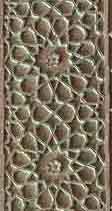REQUIRED
WORK:
*Ikram,
Chapter 15: Aurangzeb,
pp. 189-208
*Ikram,
Chapter 19: A
Century of Political Decline : 1707-1803, pp. 254-76
Online through
CU as
a "Virtual
Reading Room Text." Another source: the
public version.
*Eaton, "Mass
Conversion
to
Islam:
Theories and Protagonists," Chapter 5 (p. 113-134), and "Conclusion"
(pp. 305-315) in Richard M. Eaton,The Rise of Islam and the Bengal
Frontier,
1204-1760. Berkeley: University of California Press, 1993. BUTLER
RESERVE.
Also: at
the Univ. of California Press site. Also: online
through NetLibrary. Within their system, here is the exact
location.
NOTE: the
article by
Andre Wink listed under "Further Resources" is also a very interesting
perspective on such theories; it is highly recommended, even though not
technically required.
Eaton, Richard
M.,"Temple
Desecration
in Pre-modern India," Frontline 17,25 (Dec. 9-22, 2000), pp.
62-70:
[site].
Because
this
site is often slow to respond, the article is also
provided
in pdf form [on this
site]
Eaton, Richard
M., "Temple
Desecration
and Indo-Muslim States," Frontline 17,26 (Dec. 23, 2000-Jan. 5,
2001), pp. 70-77: [site].
Because this site is often slow to respond, the article is also
provided
in pdf form [on this
site].
*Prof.
Vinay Lal, "Aurangzeb,
Akbar, and the Communalization of History," on his interesting
large
South Asian website: "Manas."
He also provides on his site the text of "Aurangzeb's
Fatwa on Jizya" (here is *an
easily printable version*).
*"The
Death of Dara
Shukoh" (based on pp. 94-104) and "Conclusion"
(pp.
187-199) from Francois Bernier, Travels in the Mogul Empire, AD
1656-1688,
trans. by Archibald Constable, ed. by Vincent A. Smith. New Delhi: Low
Price Publications, l994 [1934]. Pp. 187-199. BUTLER RESERVE. Also,
these
passages online at CU: "The
Death of Dara Shukoh" and "Conclusion."
*"Aurangzeb
Goes to Kashmir" (c.1662-4), by Nicolai Manucci: from Storia do
Mogor (trans. Irvine, 1906-7).
*Aurangzeb's
two
last letters (1707): [on this site];
just for interest, here is the
full text of Scott's translation of Iradat Khan
POSSIBLE
PAPER TOPIC FIVE:
In "The History of the Late
Rebellion
in the States of the Great Mogol" (pp. 1-115), Francois Bernier, a
well-placed
contemporary observer, recounts the whole long, bloody succession
struggle
of Aurangzeb and his brothers. How does he interpret Aurangzeb's
character
and behavior? What general reflections on Indo-Muslim and Indian life
and
customs does he offer? What does he reveal about his own cultural
attitudes
and values? Source: Francois Bernier, Travels in the Mogul Empire,
AD
1656-1688. BUTLER RESERVE. Also: *THE
WHOLE TEXT*, courtesy of CU Libraries.



